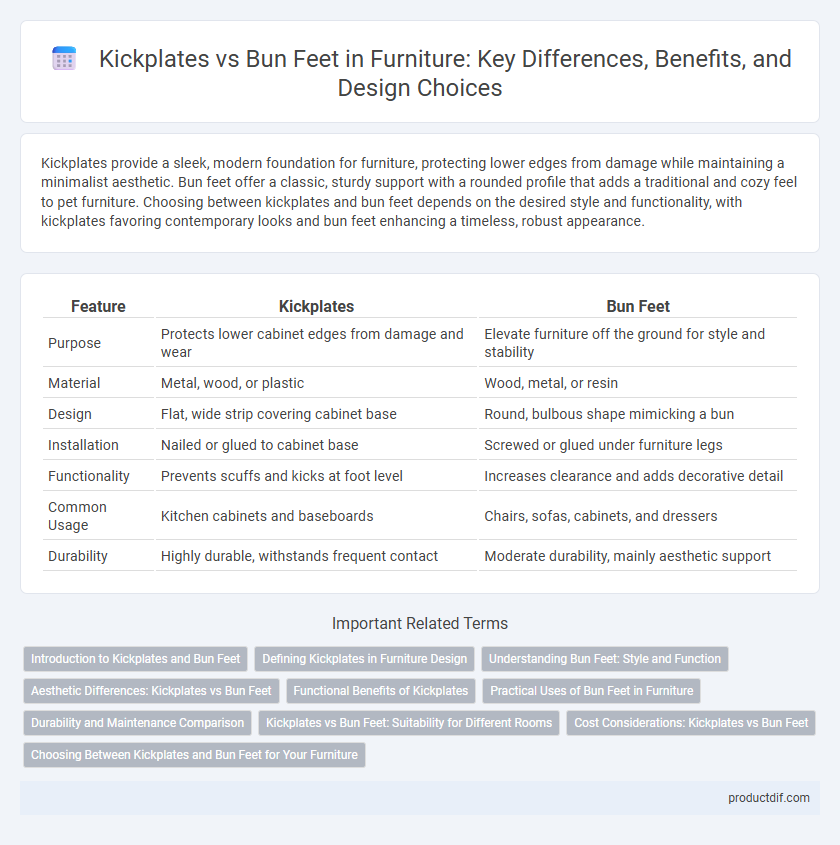Kickplates provide a sleek, modern foundation for furniture, protecting lower edges from damage while maintaining a minimalist aesthetic. Bun feet offer a classic, sturdy support with a rounded profile that adds a traditional and cozy feel to pet furniture. Choosing between kickplates and bun feet depends on the desired style and functionality, with kickplates favoring contemporary looks and bun feet enhancing a timeless, robust appearance.
Table of Comparison
| Feature | Kickplates | Bun Feet |
|---|---|---|
| Purpose | Protects lower cabinet edges from damage and wear | Elevate furniture off the ground for style and stability |
| Material | Metal, wood, or plastic | Wood, metal, or resin |
| Design | Flat, wide strip covering cabinet base | Round, bulbous shape mimicking a bun |
| Installation | Nailed or glued to cabinet base | Screwed or glued under furniture legs |
| Functionality | Prevents scuffs and kicks at foot level | Increases clearance and adds decorative detail |
| Common Usage | Kitchen cabinets and baseboards | Chairs, sofas, cabinets, and dressers |
| Durability | Highly durable, withstands frequent contact | Moderate durability, mainly aesthetic support |
Introduction to Kickplates and Bun Feet
Kickplates are protective metal or wood panels installed at the base of furniture, preventing damage from foot traffic and enhancing durability. Bun feet are rounded, often wooden legs that elevate furniture, adding a classic, sturdy aesthetic while supporting weight evenly. Both elements contribute to furniture functionality by combining protection and style in distinct ways.
Defining Kickplates in Furniture Design
Kickplates in furniture design are protective metal or wood plates installed at the base of cabinets, doors, or furniture legs to prevent damage from foot traffic and cleaning tools. They enhance durability while adding a decorative element, often featuring materials like brass or stainless steel for both functionality and aesthetic appeal. Unlike bun feet, which elevate and style furniture with rounded, solid supports, kickplates emphasize safeguarding surfaces against wear and tear.
Understanding Bun Feet: Style and Function
Bun feet, characterized by their rounded, squat design, add a classic and elegant touch to furniture pieces while providing stable support and durability. Unlike kickplates, which primarily protect the lower front surface of furniture from scuffs and damage, bun feet enhance both the aesthetics and functionality of sofas, cabinets, and tables. Their robust construction and timeless style make bun feet a preferred choice for enhancing furniture longevity and visual appeal.
Aesthetic Differences: Kickplates vs Bun Feet
Kickplates offer a sleek, linear look that enhances modern or minimalist furniture designs, providing a subtle but polished finish to cabinet bases. Bun feet create a more traditional and classic aesthetic with their rounded, bulbous shape, adding a touch of elegance and warmth to sofas, chairs, and cabinets. The choice between kickplates and bun feet significantly impacts the visual style, where kickplates emphasize clean lines and bun feet contribute to a softer, more ornate appearance.
Functional Benefits of Kickplates
Kickplates protect furniture from scuffs, scratches, and wear caused by foot traffic, significantly extending its lifespan. They provide a durable barrier at the base of cabinets and doors, preventing damage from shoes and vacuum cleaners. Unlike bun feet, kickplates offer continuous surface protection, enhancing the furniture's overall durability in high-traffic environments.
Practical Uses of Bun Feet in Furniture
Bun feet provide sturdy, rounded support for heavy furniture pieces like sofas, cabinets, and dressers, enhancing durability and stability. Their raised design protects furniture from floor moisture and makes cleaning underneath easier. Commonly made from wood or metal, bun feet contribute to both the functionality and aesthetic appeal of traditional and contemporary furniture styles.
Durability and Maintenance Comparison
Kickplates offer superior durability due to their solid metal or plastic construction, effectively protecting furniture bases from scuffs and impacts. Bun feet, typically made from wood, require more maintenance such as periodic polishing and can be prone to dents or scratches over time. When prioritizing long-term upkeep and resistance to wear, kickplates provide a more resilient and low-maintenance solution compared to bun feet.
Kickplates vs Bun Feet: Suitability for Different Rooms
Kickplates provide practical protection against scuffs and enhance durability, making them ideal for high-traffic areas like kitchens and hallways where furniture endures frequent contact. Bun feet offer a decorative and elevated look, suitable for living rooms and bedrooms where style and subtle height increase complement the space. Choosing between kickplates and bun feet depends on balancing functional needs with aesthetic preferences for specific rooms.
Cost Considerations: Kickplates vs Bun Feet
Kickplates generally offer a more budget-friendly option compared to bun feet, with prices varying based on material such as stainless steel or brass. Bun feet, often crafted from solid wood or resin, tend to have higher upfront costs due to detailed design and durable materials. When factoring in installation and long-term maintenance, kickplates typically require less upkeep, making them more cost-effective for large-scale furniture projects.
Choosing Between Kickplates and Bun Feet for Your Furniture
Choosing between kickplates and bun feet for your furniture depends on the desired aesthetic and durability needs. Kickplates provide a sleek, protective barrier at the base, ideal for modern and high-traffic pieces, while bun feet offer a classic, sturdy support that elevates furniture with a timeless appeal. Consider the material and finish of each to complement your interior design and ensure longevity.
Kickplates vs bun feet Infographic

 productdif.com
productdif.com